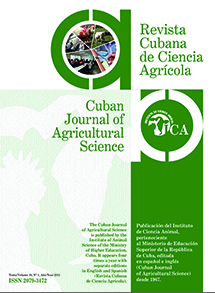Biophysical effect of climate change on summer crops
Main Article Content
Abstract
stage were used, for the decades 2020-29 and 2050-59, in order to obtain potential yields. Later, the effect of heat waves during the growth cycle 2013-14 was evaluated. Climate projections indicated an increase of yields of crops during dryland farming
crops. In soybean (Glycine max (L.) Merr.), the increase was 25 and 28 %, and in maize (Zea mays), it was 19 % and 26 %, for the decades 2020-29 and 2050-59, respectively. However, considering thermal variability imposed by the heat wave, it was evident
that soybean and maize showed a reduction of yield when they are sown without irrigation during those extreme events. Yield decreases reach 19 % in soybean and 36 % in maize. Comparing yields of crops irrigated in a year considered as typical with respect
of the year of heat wave, the increase of temperature benefits maize with a 22 % of yield increase, but harms soybean with a decrease of 13 %. Influence of temperature increase, together with water deficiencies, produces different effects on C3 species like soybean,
and in C4 like maize. It is suggested to develop more research on the effects of extreme phenomena on different phenological phases of crops so the sustainability of agroecosystems from the center of Buenos Aires province could be mantained.
Key words: food safety, heat wave, soybean, maize
Article Details
Those authors that have publications with this journal accept the following terms:
1. They will retain their copyright and guarantee the journal the right of first publication of their work, which will be simultaneously subject to the License Creative Commons Attribution-NonCommercial 4.0 International (CC BY-NC 4.0) that allows third parties to share the work whenever its author is indicated and its first publication this journal. Under this license the author will be free of:
- Share — copy and redistribute the material in any medium or format
- Adapt — remix, transform, and build upon the material
- The licensor cannot revoke these freedoms as long as you follow the license terms.
Under the following terms:
- Attribution — You must give appropriate credit, provide a link to the license, and indicate if changes were made. You may do so in any reasonable manner, but not in any way that suggests the licensor endorses you or your use.
- NonCommercial — You may not use the material for commercial purposes.
- No additional restrictions — You may not apply legal terms or technological measures that legally restrict others from doing anything the license permits.
2. The authors may adopt other non-exclusive license agreements to distribute the published version of the work (e.g., deposit it in an institutional telematics file or publish it in a monographic volume) whenever the initial publication is indicated in this journal.
3. The authors are allowed and recommended disseminating their work through the Internet (e.g. in institutional telematics archives or on their website) before and during the submission process, which can produce interesting exchanges and increase the citations of the published work. (See the Effect of open access).
